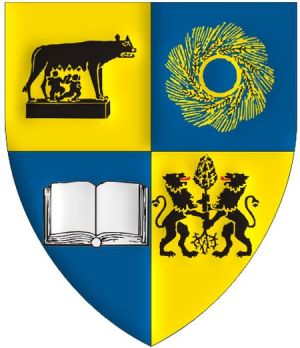Cluj (county)
CLUJ (COUNTY)
Official blazon
Un scut triunghiular cu marginile rotunjite, sfertuit. n partea superioară, în primul cartier, în dreapta, pe fond auriu, se află Lupa Capitolina, de culoare neagră. În partea superioară, în al doilea cartier, în stânga, pe fond albastru, se află o cunună de grâu aurie. În partea inferioară, în al treilea cartier, în dreapta, pe fond albastru, se află o carte argintie deschisă. În partea inferioară, în al patrulea cartier, în stânga, pe fond auriu, se află doi lei afrontați de culoare neagră, cu limba roșie, care susțin un stejar dezrădăcinat, de culoare neagră.
Origin/meaning
The arms were officially granted on February 16, 2006.
The Capitoline wolf is the symbol of Romanity, and refers to the statue donated of the Italian state in 1920. It signifies the history of the county, Cluj having several Roman settlements: Napoca (Cluj), Potaissa (Turda) and the Roman camps of Turda, Gilău, Bologa, Gherla and Caseiu.
The golden wheat wreath represents the sheaf of wheat existing on the old coats of arms of the county, symbolizing by stylization the rich folk customs of the area (the wreath on Someș).
The light silver book symbolizes culture and science, through the pattern existing here in the sixteenth century, marking the first village school documented (Jucu, fourteenth century), the Jesuit College of the sixteenth century, Piarist High School, University.
The lions symbolize the union of the three principalities - Muntenia, Transylvania, Moldova -, a heraldic sign taken from the seal of the unifying prince Mihai Viteazul.
| The arms in 1935 |
The arms during Socialist rule |
Contact and Support
Partners:
Your logo here ?
Contact us
© since 1995, Heraldry of the World, Ralf Hartemink 
Index of the siteLiterature: image from ro.wikipedia.org; DEcree 221/2006












